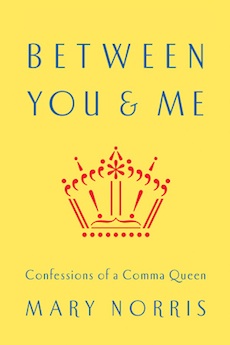By Indira Ganesan
Mary Norris tells us at the outset of her lively book, Between You and Me: Confessions of a Comma Queen, that she never intended to become a comma queen. Her first job was feet checker at a public pool in Cleveland. After stints as a dairy truck driver, a dishwasher, and as a statistical typist, Mary Norris lands a dream job in the library at The New Yorker. From there, she moved onto its copy department, meticulously proofreading page drafts of writers like John McPhee and Philip Roth. With verve and generosity, never forgetting her roots, she recounts her journey to become an inadvertant genuis of grammar, a comma queen.
Part biography, part stylebook, Norris shows us common slips of the English language that she herself overcame. As someone who had to learn in my thirties to pronounce the word “mortgage” without the “t,” I was thrilled to learn that she too had her share of pronunciation malfunctions with chimera (“ki-MAE-ra”) and detritus (“de-TRY-tus.”) Was she, like me, a reader of dictionaries as a child? She does tell us of her preference for Webster’s over the OED. She presents the joys and curiosities of language, revealing her interest in grammar was piqued in a linguistics course at college by the term “copulative verb,” a verb that “conjoins” nouns as “a plumber fits pipes, screwing the male into the female to make the two one.” Thus we have “I am a copy editor,” with am performing its conjugal duty to copy editor and I. She goes on to describe verbs as the gasoline of grammar, pronouns the grease, and nouns the air. Verbs mix with nouns, lubricated by pronouns to keep the system running. Cases are the gaskets that keep the system running smoothly. “You only notice when someone blows it,” she reminds us.
Norris is never without a sense of humor. Her chapter headings are proof: “Comma Comma Comma Comma, Chameleon”; “Who put the hyphen in Moby-Dick?” and of course, “A Dash, a Semicolon, and a Colon Walk into a Bar.” A more serious note is taken in epicene or gender-neutral gender pronouns. The awkwardness of she/he is better than the universal “he” to denote all genders, and Norris rightly points out that “using ‘their’ when you mean ‘him or her’ is just plain wrong.” Yet the usage, like kudzu, is spreading.
Later in the chapter, Norris shares that one of her siblings, Dee, is transgender. Before long, she and Dee were “engaged in a war of pronouns.” As with all wars, it ends in tears: at dinner, the author indicates that the cheeseburger the waiter arrives with is “his.” Her sibling responds, “It feels so hopeless… You say ‘That’s his,’ and don’t even know you said it.” The author, aghast, realizes “a mere pronoun had landed like a cannonball between us.” She recognizes that as if speaking a foreign language, she would need to think ahead to “the next bit of gender” to save driving her Dee into despair. It is a poignant moment, and for all of us who struggle to do right by our transgendered friends, a lesson.
Mary Norris is no mere copy editor but one for The New Yorker, that bastion of pride that still spells “theater” as “theatre” and for the past twenty odd years has been spewing four-letter words in its neat columns punctuated with ads for umbrellas, and spaces for cartoons or poetry. Norris reveals that there has been a contest to get the most instances of a certain word, and admits that she prefers the euphemism: F*ck, in which “the asterisks standing in for the vowels are interior punctuation, little fireworks inside the words.”
There are stories of famous editors and writers, of deciding whether to pursue a correction or not, for would one really want to correct Updike? My favorite chapter in this very enjoyable book, the chapter that made me recognize Mary Norris as a kindred spirit, is “The Ballad of a Pencil Junkie.” Writers and editors can be obsessive to the point of superstition over choice of paper and pen. Joyce wanted a certain yellow for printing Ulysses, Richard Hugo favored blue National brand notebooks, and Bruce Chatwin’s preference for Moleskines has produced a vast industry. Norris likes no. 1 pencils for their ability to create a dark mark. She had boxfuls to choose from the New Yorker’s supply closet, and (be still my heart) a boy actually came around in the mornings with a tray of freshly sharpened pencils “and you scooped up a quiver of them.”
Then came the day when the No. 1 was no longer offered in the catalogue. To cut to the (memorable) chase, a switch to the Blackwing 602 solved the problem. In this chapter, Norris describes a special party for pencil lovers, in which the host is appropriately dressed in “shades of pencil lead.” Another excursion heads to the Paul A. Johnson Pencil Sharpener Museum (Logan, Ohio), which she anticipates would be “like an Apple Store, but more artisanal.” There she (and thankfully, I as well) discovers that two-hole pencil sharpeners service the same pencil, the larger hole shaving off the wood, and smaller hole to sharpen the point. I had always assumed the larger hole was meant for a larger pencil. I mean to try my two-hole sharpener this way very soon.
So, Mary Norris has served up a splendid feast. Thoughtfully, she provides a list of recommended reading, and a helpful appendix. Look up pronunciation, and you are also directed to see “mispronunciation.” Between You and Me deserves a place next to your Fowlers and Strunk and White, perhaps above a copy of James Thurber, who was, it turns out, the subject of Norris’ master’s thesis.
Novelist Indira Ganesan was inducted into Phi Beta Kappa at Vassar College in 1982. Her books include The Journey (Alfred A. Knopf, 1990), Inheritance (Alfred A. Knopf, 1998) and As Sweet As Honey (Alfred A. Knopf, 2013).




